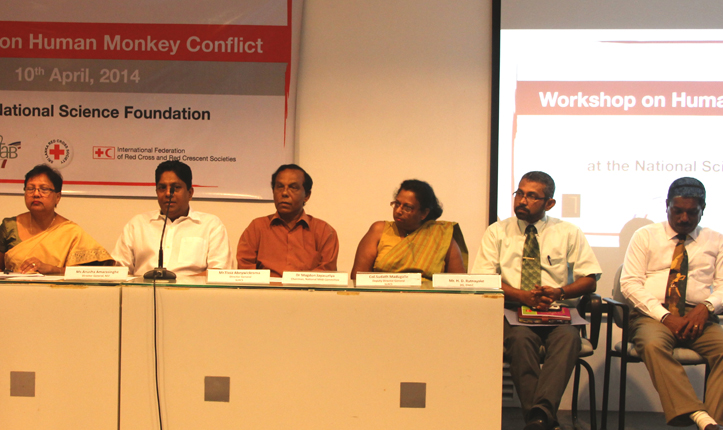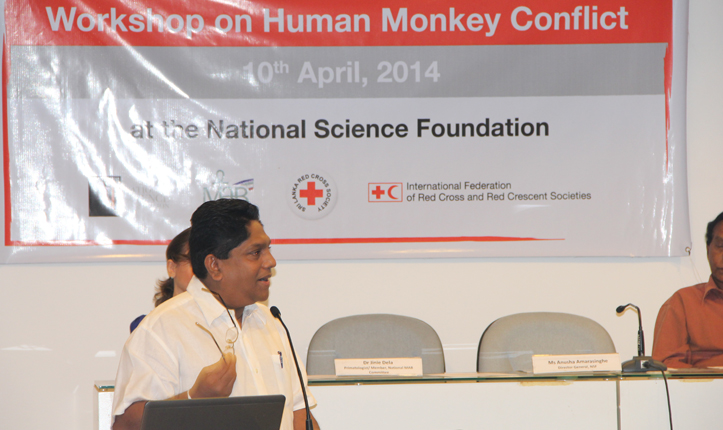Red Cross initiates a long awaited dialog on human – monkey conflicts
14/04/2014 – Colombo, Sri Lanka: The Sri Lanka Red Cross Society (SLRCS) supported by the International Federation of Red Cross & Red Crescent Societies (IFRC) has begun to look into the issue of human – monkey conflicts that has plagued certain parts of the country and continues to threaten the way of human lives.
A workshop was organized accordingly with the collaboration of the National Science Foundation of Sri Lanka and the Sri Lanka Red Cross recently. The event was held at the National Science Foundation.
In his opening remarks Tissa Abeywickrama, the Director General of SLRCS said;
The importance of this effort is well perceived to me, as this silent disaster is enduring serious difficulties to many communities in Sri Lanka. Yet at times I find hard to contemplate that it is not a manmade situation. Some people’s behaviors; currently and time ago, seem boomeranging on us. But what do we do when due limitations of land and needs we have to acquire into the animal habitat. However if we do not follow an accommodative strategy; inclusive of animals; the weaker will be destroyed and become extinct.
Let me refer to the “The Rifle and the Hound in Ceylon[1]” by Samuel Baker. In his book Mr. Baker” notes his experiences in Sri Lanka in 1800’s, then Ceylon. Wherein this particular new edition of “the Rifle and the Hound in Ceylon” he has added a preface and is comparing the changes of environment, existence and the extent of forest and animal habitat say between 1870 and 1890 just over 20 years in Sri Lanka.
A part in his preface, I quote;
“The long interval that has elapsed since I was in Ceylon, has caused a great diminution in the wild animals.
The elephants are now protected by game laws, although twenty years ago a reward was offered by the Government for their destruction. The ‘Rifle and Hound’ can no longer be accepted as a guide book to the sports in Ceylon; the country is changed, and in many districts the forests have been cleared, and civilization has advanced in to the domains of wild beasts. The colony has been blessed with prosperity, and the gradual decrease of game is a natural consequence of extended cultivation and increased population.
In the pages of this book it will be seen that I foretold the destruction of the wild deer and other animals twenty years ago. At that time the energetic Tamby’s or Moormen were possessed of guns, and had commenced a deadly warfare in the jungles, killing the wild animals as a matter of business, and making a livelihood by the sale of dried flesh, hides, and buffalo – horns. This unremitting slaughter of the game during all seasons has been most disastrous, and at length necessitated the establishment of laws for its protection.” I unquote.
From 1800’s rapid changes have been made to the environment and especially many forests have been cleared in the country to meet the colonial needs. We have encroached to animal’s domains, resulting conflicts, thus with monkeys. It may be that our actions cause enormous agony and plight to wild life. However, If our choice is to coexist with animals, as monkeys are not represented by them I raise my voice and ask you to bring their perspective too into our dialog and find converging and cohesive way forwards to live in consideration with wild animals.
The Deputy Director General of SLRCS Sudath Madugalle, Primatologist Dr. Jinie Dela, Director General of National Science Foundation Anusha Amarasinghe, Chairman of MAB Committee Dr. Magdon Jayasuriya were among the distinguished guests present at the event.
[1]Baker, S. W., 1892. The Rifle and the Hound in Ceylon. New edition ed. London: Longmans, Green, and Co..

